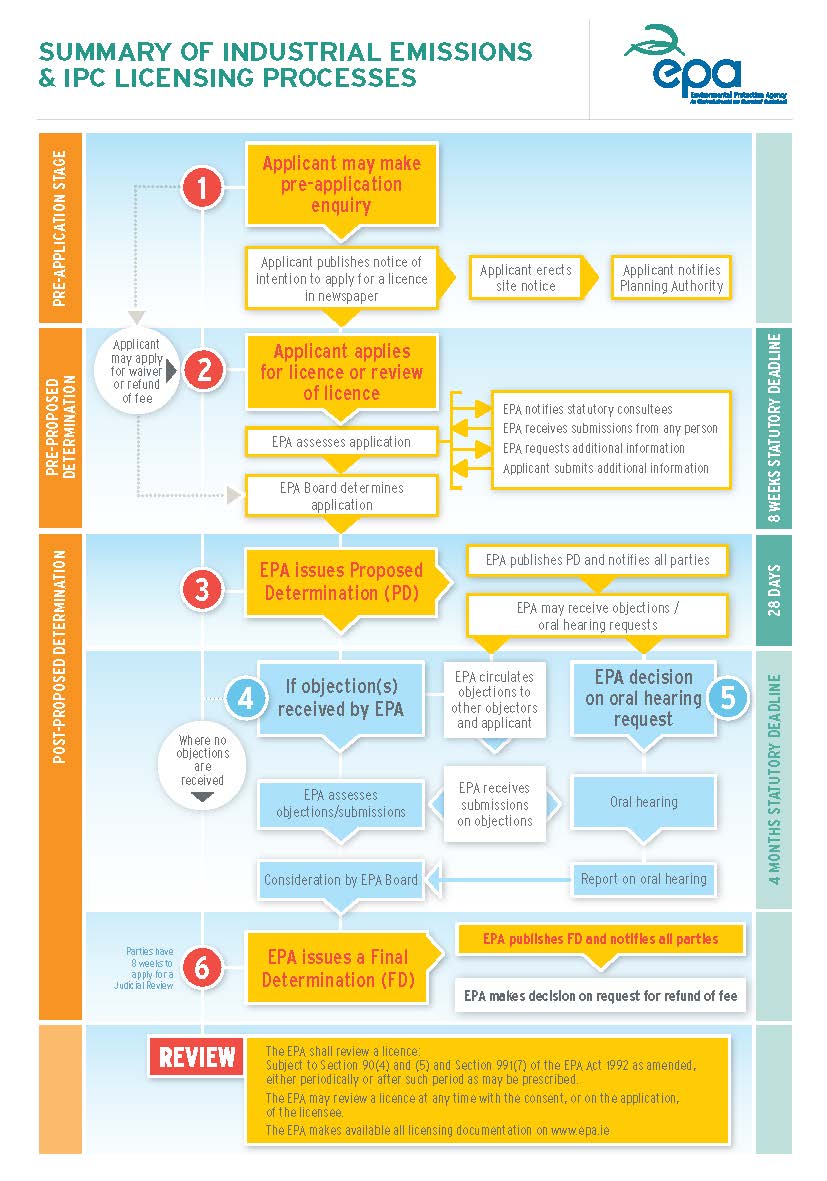The industrial emissions licensing process
There are a number of stages in the licensing process:
Stage 1: Pre-application
Before making an application the applicant:
- publishes a notice in a newspaper circulating in the area;
- erects a notice on the site indicating that they propose to apply for a licence; and
- notifies the planning authority.
Stage 2: Applicant applies for a licence How to apply for a licence
The application is submitted online.
- The EPA notifies statutory consultees.
- The application is published on this website.
- Anyone can make a submission on the application.
- The EPA requests further information if necessary.
- The EPA assesses the application.
We have eight weeks to assess the application before making a "proposed determination". The eight-week period starts when all requests have been complied with. This period may be extended in certain circumstances.
Before making a proposed determination we will take into account any submissions received.
Stage 3: EPA issues a proposed determination
The EPA indicates how we propose to determine an application. We will:
- publish a newspaper notice;
- advise anyone who made a submission;
- publish the proposed determination on this website; and
- notify statutory public bodies.
Stage 4: Objections
- Anyone (including the applicant) can make an objection to the proposed determination within 28 days.
- Anyone who submits an objection is given a copy of all objections.
- Objectors can make a submission in relation to any objection within one month.
- Anyone who makes an objection may request an oral hearing.
- The EPA considers objections, oral hearing requests & submissions on objections.
- If no valid objection is made within 28 days, we issue the Licence as per the Proposed Determination.
Stage 5: Oral hearing
- An oral hearing of objections may be held.
- The oral hearing report is submitted to the EPA.
Stage 6: EPA issues licence
Before making a final decision, we consider the application and any objections / submissions on objections /oral hearing report.
When we issue a licence, we notify:
- the applicant;
- anyone who made a submission;
- anyone who made an objection; and
- specified public bodies.
We publish the final decision on this website and in a newspaper circulating in the area.
Judicial Review
Once a decision has issued, anyone can apply to the High Court and seek a judicial review of the validity of the decision. This must be done within 8 weeks of the decision under Order 84 of the Rules of the Superior Courts (as amended). The Rules of the Superior Courts and all relevant amendments can be found at The Courts Service of Ireland
Further information on Judicial Review in environmental and planning matters may be found at: www.citizensinformation.ie
Review of an existing licence
All requests from Licensees to carry out alterations or reconstruction works that effect emissions on site will be considered by the EPA’s Office of Environmental Enforcement. If the Office of Environmental Enforcement believes that the works or measures cannot be accommodated within the terms of the existing Licence, the Licensee is notified accordingly.
If a review of an existing licence is necessary, the Licensee must submit their review application online. The review process is the same as applying for an Industrial Emissions Licence.
The EPA can also initiate a review of a Licence in certain circumstances. These circumstances are outlined in Section 87 (1)(b) of the EPA Act 1992 as amended.
Application Prioritisation Scoring System
The Application Prioritisation Scoring System outlines the OES-ELP application prioritisation criteria for IED, IPC and Waste Licensed installations. All applications are assessed against specified criteria and given a prioritisation score. This determines the work programme, in relation to sequence in which applications will be progressed to decision. These prioritisation criteria allow all stakeholders to clearly see the aspects of an activity which are considered during OES- ELP’s work programme planning stage.
